
Status: Final Blueprint (Summary)
Author: Shahab Al Yamin Chawdhury
Organization: Principal Architect & Consultant Group
Research Date: June 1, 2024
Location: Dhaka, Bangladesh
Version: 1.0
1. The Core Dilemma: Assessor vs. Builder Mindset

We are observing worldwide adoption on CISSP certification by anyone who are not even technical personnel, let alone the auditors. People who are working in the technology industry has different preferences for ceritifcations either on CISSP or CISM where both are equally tough, and there are thousands of scenarios where CISSP’s failed the CISM exam. Choices of becoming a CISSP and having no working domain knowledge on architecting a platform yields only headache for the team, and the team can readily identify their coleagues knowledge gap easily. Life is never easy, there is no shortcut, except you can use the profile for training! and good luck on having trained by these folks, if you think thats a grand idea.
The central challenge in this hiring scenario is the fundamental conflict between the professional mandates of an IT Auditor and an Infrastructure Platform Manager.
- The IT Auditor (The Assessor):
- Mandate: Verification and validation of existing systems against established standards (e.g., NIST, SOX, ISO).
- Posture: Retrospective and evidence-based. Their work involves finding flaws, gaps, and non-compliance in systems that are already built.
- Value: Measured by the accuracy and impact of their audit reports and findings.
- The Infrastructure Manager (The Builder):
- Mandate: Creation, implementation, and operation of the entire technology lifecycle.
- Posture: Proactive, strategic, and constructive. Their work is forward-looking, focused on designing and building resilient, scalable systems.
- Value: Measured by tangible KPIs like system uptime, performance, and successful project delivery.
Conclusion: The candidate’s experience is rooted in deconstructing and analyzing finished products. The target role requires the creation and management of those products from inception, often amidst ambiguity and operational pressure. This represents a significant philosophical and practical gap.
2. The CISSP Paradox: A Managerial Credential for a Technical Role
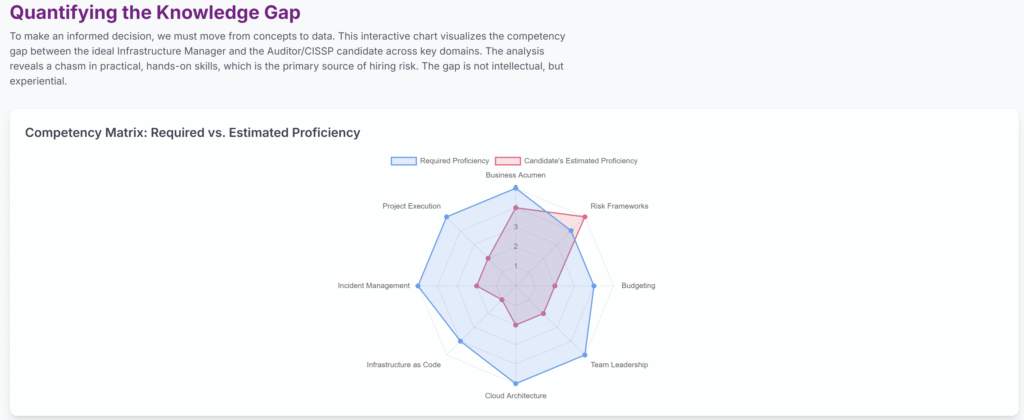
The candidate’s CISSP certification adds a layer of complexity. While it signals security expertise, it may also reinforce the experiential gap.
- What the CISSP Provides:
- Strategic Mindset: The certification validates a high-level, managerial understanding of security governance, risk management, and business alignment. This is a key strength for a leadership role.
- Holistic Security View: A CISSP holder understands the broad ecosystem of security, from assets to operations, which is valuable for integrated infrastructure design.
- The “Mile Wide, Inch Deep” Limitation:
- Lack of Hands-On Validation: The CISSP is a knowledge-based exam that does not test practical, hands-on implementation skills. It teaches the “what” and “why” of secure design, not the “how” of configuring a firewall or architecting a cloud environment.
- Reinforces the Auditor’s Strengths: Many CISSP domains, such as “Security and Risk Management” and “Security Assessment and Testing,” align perfectly with the candidate’s existing audit background, rather than bridging the gap toward operational and engineering duties.
Conclusion: The CISSP makes the candidate appear more qualified for management on paper but does not certify the hands-on technical credibility required to lead an engineering team effectively, specially when the infrastructure insights is required to respond to critical flaws, when attacked.
3. Quantifying the Knowledge Gap
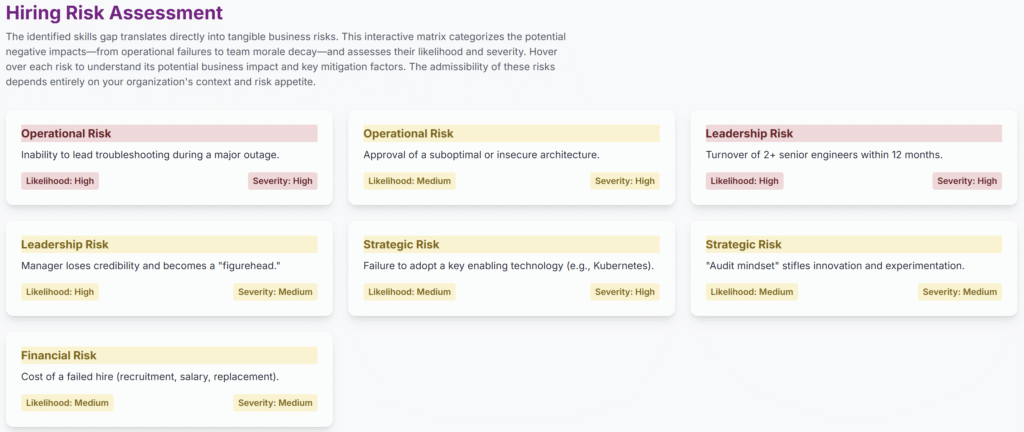
A formal skills gap analysis reveals a chasm that is primarily experiential, not intellectual. The candidate likely has the capacity to learn, but the skills they lack are honed through years of hands-on practice.
- Key Synergy Areas (Strengths):
- Risk Management Frameworks (NIST, ISO)
- Regulatory & Compliance Knowledge (SOX, GDPR)
- Business Acumen & Alignment
- Stakeholder Communication & Reporting
- Critical Gap Areas (Weaknesses):
- Technical (Cloud & On-Premise): Cloud Platform Architecture (AWS/Azure), Infrastructure as Code (Terraform/Ansible), Network Engineering, and Systems Administration.
- Operational: Real-Time Incident Management, Disaster Recovery Execution, and technical troubleshooting under pressure.
- Leadership: Mentorship of technical staff and hands-on project execution and estimation.
Conclusion: The gap’s impact is most severe under stress. During a crisis (e.g., a major outage), the manager’s lack of deep technical credibility would be exposed, risking a loss of trust from their team and poor business outcomes.
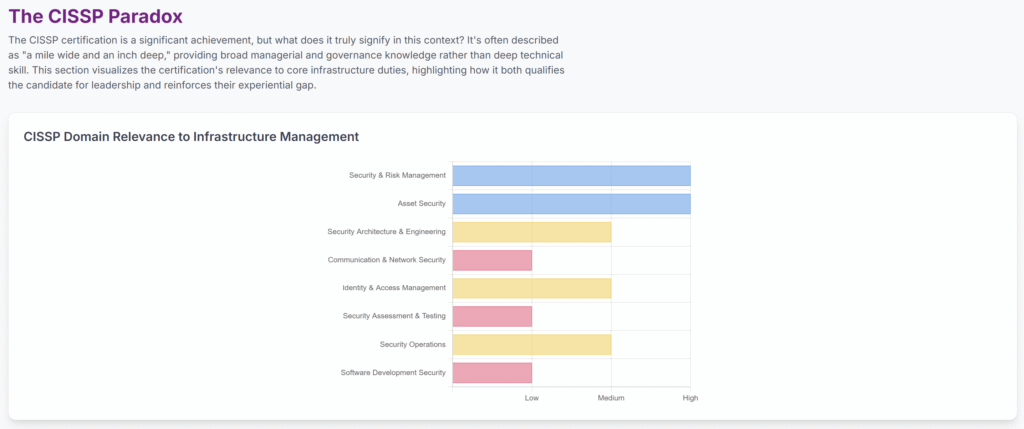
4. Risk Assessment: Is the Gap Admissible?
The knowledge gap translates into four primary categories of business risk. The admissibility of these risks depends entirely on the organization’s context and risk appetite.
- 1. Operational Risk: Increased system downtime, project failures due to poor technical planning, and accumulation of technical debt.
- 2. Leadership & Team Morale Risk: Loss of credibility with senior engineers, inability to provide technical mentorship, and high turnover of top talent. This can lead to a “team morale death spiral”.
- 3. Strategic Risk: Technological stagnation due to a risk-averse “audit mindset” and an inability to translate business goals into a forward-looking technology roadmap.
- 4. Financial Risk: The direct costs of a failed hire (recruitment, salary) and the indirect costs of remediation and lost productivity.
Context is Key: The risks are more admissible if the organization has a mature, self-sufficient technical team with a strong tech lead, is in a stable operational period, and has robust mentorship structures. The risks are likely inadmissible in a chaotic environment requiring rapid innovation.
5. Bridging the Chasm: A Strategic Mitigation Plan
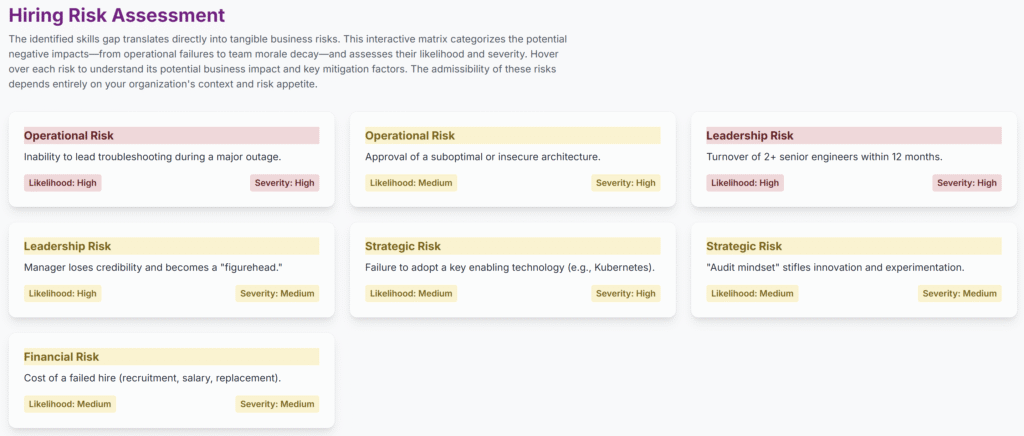
Hiring this candidate is only viable if treated as a strategic investment, backed by a formal development and integration plan.
- 1. Formal Upskilling:
- Mandatory Certifications: Require practical, hands-on certifications in the company’s core technologies (e.g., AWS/Azure associate-level certs).
- Hands-On Labs: Provide a subscription to a lab platform (e.g., A Cloud Guru) for practical, sandboxed learning.
- 2. Structural Support:
- The Critical Deputy/Tech Lead: The single most effective mitigation is to pair the new manager with an empowered and respected Technical Lead. The manager focuses on budget, stakeholders, and removing roadblocks, while the Tech Lead owns the technical roadmap and decisions.
- Formal Mentorship: Assign a peer-level technical director or senior architect as a formal mentor to provide a safe channel for guidance.
- 3. Strategic Reframing:
- “Build vs. Buy” Talent: View the hire as a “build” decision—investing in a candidate with a strong, hard-to-teach strategic foundation while teaching them the more acquirable technical skills.
- Build Trust Through Transparency: Openly acknowledge the gap with the team and present the mitigation plan. This turns a potential conflict into a collaborative effort.
6. The Final Verdict: A Context-Dependent Decision
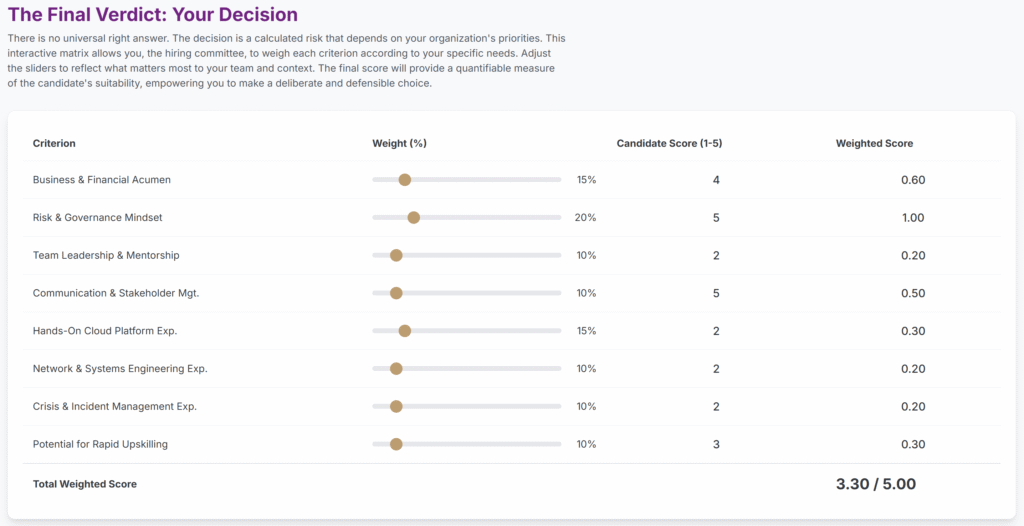
There is no universal right answer. The decision must be made through a structured framework that weighs the organization’s specific priorities.
- The Case FOR Hiring: The candidate offers a rare combination of strategic vision, risk management expertise, and business acumen. With a structured support system, the organization can develop a uniquely well-rounded leader who bridges the gap between governance and technology.
- The Case AGAINST Hiring: The immediate technical and operational gaps pose a critical short-term risk to stability, team morale, and innovation. Without the right support structures and organizational maturity, the probability of failure is unacceptably high.
The knowledge gap is ADMISSIBLE if:
- The technical team is mature and has a strong, established Tech Lead.
- The organization is in a stable operational state.
- The strategic priority is improving governance, process, and risk control.
- The company is committed to funding a formal upskilling and mentorship plan.
The knowledge gap is INADMISSIBLE if:
- The technical team is junior or lacks senior leadership.
- The organization is in a crisis or undergoing rapid, chaotic transformation.
- The strategic priority is aggressive technological innovation and speed.
- The company lacks the resources or culture for intensive talent development.